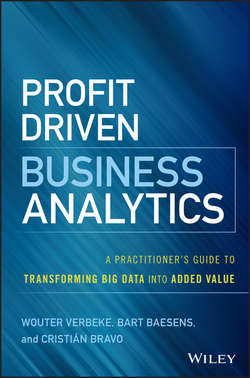Читать книгу Profit Driven Business Analytics - Baesens Bart - Страница 15
На сайте Литреса книга снята с продажи.
CHAPTER 2
Analytical Techniques
INTRODUCTION
ОглавлениеData are everywhere. IBM projects that every day we generate 2.5 quintillion bytes of data. In relative terms, this means 90 % of the data in the world has been created in the last two years. These massive amounts of data yield an unprecedented treasure of internal knowledge, ready to be analyzed using state-of-the-art analytical techniques to better understand and exploit behavior about, for example, your customers or employees by identifying new business opportunities together with new strategies. In this chapter, we zoom into analytical techniques. As such, the chapter provides the backbone for all other subsequent chapters. We build on the analytics process model reviewed in the introductory chapter to structure the discussions in this chapter and start by highlighting a number of key activities that take place during data preprocessing. Next, the data analysis stage is elaborated. We turn our attention to predictive analytics and discuss linear regression, logistic regression, decision trees, neural networks, and random forests. A subsequent section elaborates on descriptive analytics such as association rules, sequence rules and clustering. Survival analysis techniques are also discussed, where the aim is to predict the timing of events instead of only event occurrence. The chapter concludes by zooming into social network analytics, where the goal is to incorporate network information into descriptive or predictive analytical models. Throughout the chapter, we discuss standard approaches for evaluating these different types of analytical techniques, as highlighted in the final stage of the analytical process model.
